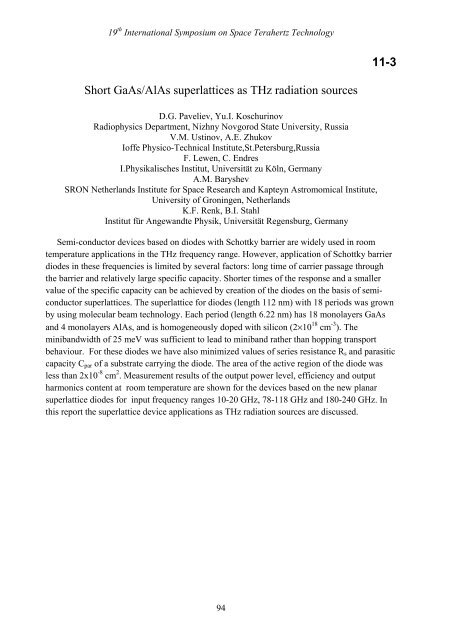Program and Abstract Book - SRON
Program and Abstract Book - SRON
Program and Abstract Book - SRON
You also want an ePaper? Increase the reach of your titles
YUMPU automatically turns print PDFs into web optimized ePapers that Google loves.
19 th International Symposium on Space Terahertz Technology<br />
11-3<br />
Short GaAs/AlAs superlattices as THz radiation sources<br />
D.G. Paveliev, Yu.I. Koschurinov<br />
Radiophysics Department, Nizhny Novgorod State University, Russia<br />
V.M. Ustinov, A.E. Zhukov<br />
Ioffe Physico-Technical Institute,St.Petersburg,Russia<br />
F. Lewen, C. Endres<br />
I.Physikalisches Institut, Universität zu Köln, Germany<br />
A.M. Baryshev<br />
<strong>SRON</strong> Netherl<strong>and</strong>s Institute for Space Research <strong>and</strong> Kapteyn Astromomical Institute,<br />
University of Groningen, Netherl<strong>and</strong>s<br />
K.F. Renk, B.I. Stahl<br />
Institut für Angew<strong>and</strong>te Physik, Universität Regensburg, Germany<br />
Semi-conductor devices based on diodes with Schottky barrier are widely used in room<br />
temperature applications in the THz frequency range. However, application of Schottky barrier<br />
diodes in these frequencies is limited by several factors: long time of carrier passage through<br />
the barrier <strong>and</strong> relatively large specific capacity. Shorter times of the response <strong>and</strong> a smaller<br />
value of the specific capacity can be achieved by creation of the diodes on the basis of semiconductor<br />
superlattices. The superlattice for diodes (length 112 nm) with 18 periods was grown<br />
by using molecular beam technology. Each period (length 6.22 nm) has 18 monolayers GaAs<br />
<strong>and</strong> 4 monolayers AlAs, <strong>and</strong> is homogeneously doped with silicon (2×10 18 cm -3 ). The<br />
minib<strong>and</strong>width of 25 meV was sufficient to lead to minib<strong>and</strong> rather than hopping transport<br />
behaviour. For these diodes we have also minimized values of series resistance R s <strong>and</strong> parasitic<br />
capacity C par of a substrate carrying the diode. The area of the active region of the diode was<br />
less than 2х10 -8 cm 2 . Measurement results of the output power level, efficiency <strong>and</strong> output<br />
harmonics content at room temperature are shown for the devices based on the new planar<br />
superlattice diodes for input frequency ranges 10-20 GHz, 78-118 GHz <strong>and</strong> 180-240 GHz. In<br />
this report the superlattice device applications as THz radiation sources are discussed.<br />
94
















